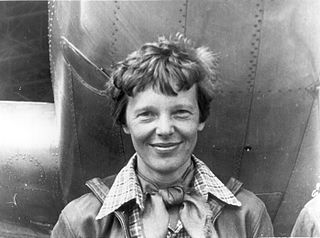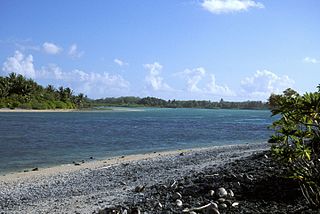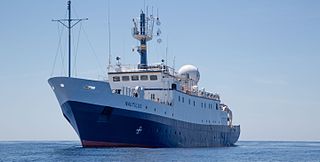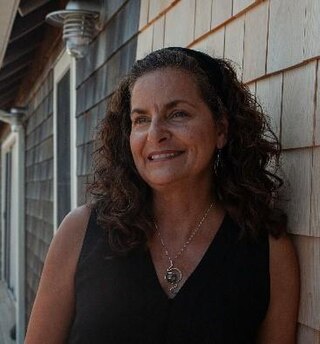
Howland Island is an uninhabited coral island located just north of the equator in the central Pacific Ocean, about 1,700 nautical miles (3,100 km) southwest of Honolulu. The island lies almost halfway between Hawaii and Australia and is an unorganized, unincorporated territory of the United States. Together with Baker Island it forms part of the Phoenix Islands. For statistical purposes, Howland is grouped as one of the United States Minor Outlying Islands. The island has an elongated cucumber-shape on a north–south axis, 1.40 by 0.55 miles, and covers 1 square mile.

Amelia Mary Earhart was an American aviation pioneer and writer. Earhart was the first female aviator to fly solo across the Atlantic Ocean. She set many other records, was one of the first aviators to promote commercial air travel, wrote best-selling books about her flying experiences, and was instrumental in the formation of The Ninety-Nines, an organization for female pilots.

Robert Duane Ballard is an American retired Navy officer and a professor of oceanography at the University of Rhode Island who is most noted for his work in underwater archaeology: maritime archaeology and archaeology of shipwrecks. He is best known for the discoveries of the wrecks of the RMS Titanic in 1985, the battleship Bismarck in 1989, and the aircraft carrier USS Yorktown in 1998. He discovered the wreck of John F. Kennedy's PT-109 in 2002 and visited Biuku Gasa and Eroni Kumana, who saved its crew.

Nikumaroro, previously known as Kemins Island or Gardner Island, is a part of the Phoenix Islands, Kiribati, in the western Pacific Ocean. It is a remote, elongated, triangular coral atoll with profuse vegetation and a large central marine lagoon. Nikumaroro is about 7.5 km (4.7 mi) long by 2.5 km (1.6 mi) wide. The rim has two narrow entrances, both of which are blocked by a wide reef, which is dry at low tide. The ocean beyond the reef is very deep, and the only anchorage is at the island's west end, across the reef from the ruins of a mid-20th-century British colonial village, but this is safe only with the southeast trade winds. Landing has always been difficult and is most often done south of the anchorage. Although occupied at various times during the past, the island is uninhabited today.

Frederick Joseph "Fred" Noonan was an American flight navigator, sea captain and aviation pioneer, who first charted many commercial airline routes across the Pacific Ocean during the 1930s. Navigator for Amelia Earhart, they disappeared somewhere over the Central Pacific Ocean, on July 2, 1937. during one of the last legs of their attempted pioneering round-the-world flight.

Sir George Hubert Wilkins MC & Bar, commonly referred to as Captain Wilkins, was an Australian polar explorer, ornithologist, pilot, soldier, geographer and photographer. He was awarded the Military Cross after he assumed command of a group of American soldiers who had lost their officers during the Battle of the Hindenburg Line, and became the only official Australian photographer from any war to receive a combat medal. He narrowly failed in an attempt to be the first to cross under the North Pole in a submarine, but was able to prove that submarines were capable of operating beneath the polar ice cap, thereby paving the way for future successful missions. The US Navy later took his ashes to the North Pole aboard the submarine USS Skate on 17 March 1959.

Will Steger is a prominent spokesperson for the understanding and preservation of the Arctic and has led some of the most significant feats in the field of dogsled expeditions; such as the first confirmed dogsled journey to the North Pole in 1986, the 1,600-mile south–north traverse of Greenland - the longest unsupported dogsled expedition in history at that time in 1988, the historic 3,471-mile International Trans-Antarctic Expedition - the first dogsled traverse of Antarctica (1989–90), and the International Arctic Project - the first and only dogsled traverse of the Arctic Ocean from Russia to Ellesmere Island in Canada during 1995.
The International Group for Historic Aircraft Recovery (TIGHAR) is an American nonprofit organization based in Pennsylvania. It was founded by Richard Gillespie in 1985. According to TIGHAR's Federal Tax Exemption Form 990 for Non Profits, the organization's mission is to "promote responsible aviation archaeological and historic preservation".

James Preston Delgado is a maritime archaeologist, historian, maritime preservation expert, author, television host, and explorer.

Elgen Marion Long was an American aviator and author who set fifteen aviation records and firsts, including his 1971 flight around the world over both poles. He received the FAI Gold Air Medal for his accomplishment. He developed a "Crash and Sink" theory explaining the disappearance of Amelia Earhart. For over 35 years, Long researched the last leg of Earhart's flight in an attempt to determine where her Lockheed Electra crashed. He and his wife Marie K. Long documented the people and data involved in the disappearance, a collection that is held by the SeaWord Foundation.

Amelia is a 2009 biographical film about the life of Amelia Earhart. Most of the story is told in flashbacks before ending with Earhart's mysterious disappearance. The film was directed by Mira Nair and based on The Sound of Wings by Mary S. Lovell. The film has received mainly negative reviews.

NOAAS Okeanos Explorer is a converted United States Navy ship, now an exploratory vessel for the National Oceanic and Atmospheric Administration (NOAA), officially launched in 2010. Starting in 2010, NOAA entered into a five-year partnership with the San Francisco Exploratorium. The focus is on gathering scientific information about oceans for the public as well as for scientific uses. As much as 95% of the ocean remains unexplored, NOAA officials said. The ship is equipped with cameras and will provide real-time viewing of the ocean floor for scientists and for the public.
David Walter Jourdan is an author, founder of Meridian Sciences, and the co-founder and president of Nauticos, a deep ocean exploration company. He studied physics and engineering at the U.S. Naval Academy and Johns Hopkins University, and served as a U.S. Navy submarine officer during the Cold War. Jourdan and his Nauticos team have made a number of notable deep ocean discoveries, including the missing Israeli submarine INS Dakar in the Mediterranean and the Japanese aircraft carrier Kaga, sunk in the battle of Midway. Most recently he has led two deep ocean expeditions in search of Amelia Earhart’s lost Lockheed Electra airplane. He has published several books, Never Forgotten: the Search and Discovery of Israel's Lost Submarine Dakar; The Deep Sea Quest for Amelia Earhart.; and The Search for the Japanese Fleet: USS Nautilus and the Battle of Midway.

EVNautilus is a 68-meter (223 ft) research vessel owned by the Ocean Exploration Trust under the direction of Robert Ballard, the researcher known for finding the wreck of the Titanic and the German battleship Bismarck. The vessel's home port is at the AltaSea facility in San Pedro in the Port of Los Angeles, California. Nautilus is equipped with a team of remotely operated vehicles (ROVs), Hercules, Argus, Little Hercules, and Atalanta, a multibeam mapping system, and mapping tools Diana and Echo, allowing it to conduct deep sea exploration of the ocean to a depth of 4,000 meters (13,000 ft).

Amelia Earhart: The Lost Evidence is a 2017 documentary broadcast by the US television network History that purported to have new evidence supporting the Japanese capture hypothesis of the disappearance of Amelia Earhart and Fred Noonan. Its main piece of evidence, a photograph purportedly showing the two still alive after their 1937 disappearance, was soon proven to have been published in 1935, and subsequent showings of the documentary were cancelled.

Katy Croff Bell is a marine explorer who has been on more than 30 oceanographic and archaeological expeditions including in the Black Sea, the Mediterranean, the Gulf of Mexico, the Caribbean Sea, and the Pacific Ocean. She is also an American Association for Advancement of Science If/Then Ambassador in recognition of her work to interest girls in STEM careers.

This expedition was the final of three expeditions on the NOAAS Okeanos Explorer intended to increase the understanding of the deep-sea environment in the Gulf of Mexico. Gulf of Mexico 2018 was a 23-day telepresence-enabled expedition to collect critical information and acquire data on priority exploration areas identified by the ocean management and scientific communities. The goal of the expedition was to use remotely operated vehicle (ROV) dives in combination with seafloor mapping operations to increase the understanding of deep-sea ecosystems and collect scientific information to support future management decisions. The expedition lasted from 11 April 2018 to 3 May 2018.

Darlene Sze Shien Lim is a NASA geobiologist and exobiologist who prepares astronauts for scientific exploration of the Moon, Deep Space and Mars. Her expertise involves Mars human analog missions, in which extreme landscapes like volcanoes and Arctic deserts serve as physical or operational substitutes for various planetary bodies. She has become a leading public figure for Mars exploration, having presented her missions publicly at academic institutions and public events around the world. She has also discussed her work for various media groups such as NPR, The New York Times, and The Washington Post.
Elizabeth Trembath-Reichert is a geomicrobiologist and astrobiologist at Arizona State University's School of Earth and Space Exploration.

Catalina Martinez is a regional program manager for the National Oceanic and Atmospheric Administration's (NOAA) Office of Ocean Exploration and Research (OER). She attended the University of Rhode Island for both her undergraduate and graduate studies. She is currently based at the University of Rhode Island's Graduate School of Oceanography. Her career focuses on coordinating programs for NOAA as well as promoting diversity and inclusion for underrepresented communities in STEM.
















